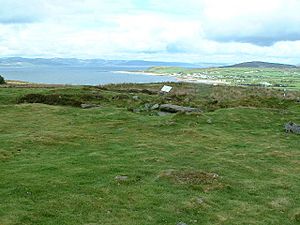Kilpatrick Dun facts for kids

Kilpatrick Dun
|
|
| Location | Isle of Arran |
|---|---|
| Coordinates | 55°29′05″N 5°18′53″W / 55.484606°N 5.314788°W |
| Type | Dun |
| History | |
| Periods | Iron Age |
| Site notes | |
| Ownership | Historic Scotland |
| Public access | Yes |
Kilpatrick Dun is an ancient stone fort found on the Isle of Arran in Scotland. It was built during the Iron Age, a time when people started using iron tools. This historic site is located about 1.6 kilometers (1 mile) south of the village of Blackwaterfoot.
What is a Dun?
A dun (pronounced "dun") is a type of fortified home or small castle. These structures were common in western Scotland during the later Iron Age. They were built to protect families or small groups of people. Duns often had thick stone walls, making them strong and safe.
Exploring Kilpatrick Dun
Kilpatrick Dun sits on flat ground on the side of a hill. You can reach it easily with a short walk from a nearby car park. For a long time, people weren't sure what this site was. Some thought it might be a Bronze Age burial mound. Others believed it was an early Christian monastery.
Today, most experts agree that Kilpatrick Dun was a fortified home. It is a great example of an Iron Age dun. Another similar dun, called Torr a'Chaisteal, is located about 4 kilometers (2.5 miles) to the south.
The Dun's Structure
The main part of Kilpatrick Dun is circular. It measures about 17 meters (56 feet) across. The walls are very thick, more than 8 meters (26 feet) in some places! The entrance to the dun is on the south side and is about 1.2 meters (4 feet) wide. Inside the thick walls, you can see four small chambers or rooms.
The Outer Enclosure
The dun is surrounded by a large outer wall or enclosure. This enclosure looks a bit like a "cashel," which was a type of stone wall around early Christian monasteries. However, there are also small rectangular buildings next to this outer wall. These buildings were likely part of a "croft" or "bothy" from a much later time, after the medieval period. A croft was a small farm, and a bothy was a simple shelter.


